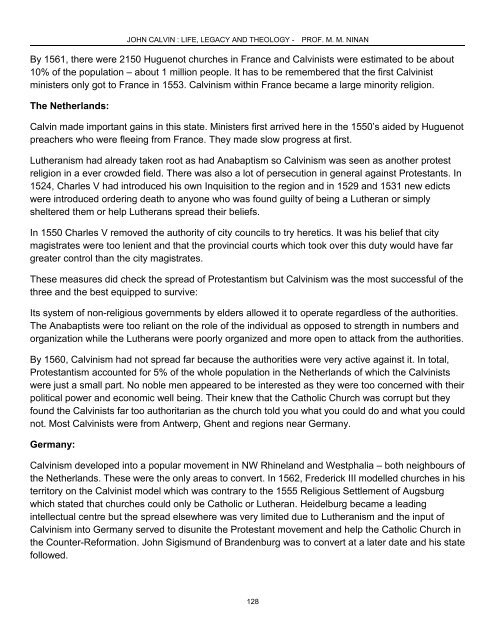You also want an ePaper? Increase the reach of your titles
YUMPU automatically turns print PDFs into web optimized ePapers that Google loves.
JOHN CALVIN : LIFE, LEGACY AND THEOLOGY -<br />
PROF. M. M. NINAN<br />
By 1561, there were 2150 Huguenot churches in France <strong>and</strong> <strong>Calvin</strong>ists were estimated to be about<br />
10% of the population – about 1 million people. It has to be remembered that the first <strong>Calvin</strong>ist<br />
ministers only got to France in 1553. <strong>Calvin</strong>ism within France became a large minority religion.<br />
The Netherl<strong>and</strong>s:<br />
<strong>Calvin</strong> made important gains in this state. Ministers first arrived here in the 1550’s aided by Huguenot<br />
preachers who were fleeing from France. They made slow progress at first.<br />
Lutheranism had already taken root as had Anabaptism so <strong>Calvin</strong>ism was seen as another protest<br />
religion in a ever crowded field. There was also a lot of persecution in general against Protestants. In<br />
1524, Charles V had introduced his own Inquisition to the region <strong>and</strong> in 1529 <strong>and</strong> 1531 new edicts<br />
were introduced ordering death to anyone who was found guilty of being a Lutheran or simply<br />
sheltered them or help Lutherans spread their beliefs.<br />
In 1550 Charles V removed the authority of city councils to try heretics. It was his belief that city<br />
magistrates were too lenient <strong>and</strong> that the provincial courts which took over this duty would have far<br />
greater control than the city magistrates.<br />
These measures did check the spread of Protestantism but <strong>Calvin</strong>ism was the most successful of the<br />
three <strong>and</strong> the best equipped to survive:<br />
Its system of non-religious governments by elders allowed it to operate regardless of the authorities.<br />
The Anabaptists were too reliant on the role of the individual as opposed to strength in numbers <strong>and</strong><br />
organization while the Lutherans were poorly organized <strong>and</strong> more open to attack from the authorities.<br />
By 1560, <strong>Calvin</strong>ism had not spread far because the authorities were very active against it. In total,<br />
Protestantism accounted for 5% of the whole population in the Netherl<strong>and</strong>s of which the <strong>Calvin</strong>ists<br />
were just a small part. No noble men appeared to be interested as they were too concerned with their<br />
political power <strong>and</strong> economic well being. Their knew that the Catholic Church was corrupt but they<br />
found the <strong>Calvin</strong>ists far too authoritarian as the church told you what you could do <strong>and</strong> what you could<br />
not. Most <strong>Calvin</strong>ists were from Antwerp, Ghent <strong>and</strong> regions near Germany.<br />
Germany:<br />
<strong>Calvin</strong>ism developed into a popular movement in NW Rhinel<strong>and</strong> <strong>and</strong> Westphalia – both neighbours of<br />
the Netherl<strong>and</strong>s. These were the only areas to convert. In 1562, Frederick III modelled churches in his<br />
territory on the <strong>Calvin</strong>ist model which was contrary to the 1555 Religious Settlement of Augsburg<br />
which stated that churches could only be Catholic or Lutheran. Heidelburg became a leading<br />
intellectual centre but the spread elsewhere was very limited due to Lutheranism <strong>and</strong> the input of<br />
<strong>Calvin</strong>ism into Germany served to disunite the Protestant movement <strong>and</strong> help the Catholic Church in<br />
the Counter-Reformation. <strong>John</strong> Sigismund of Br<strong>and</strong>enburg was to convert at a later date <strong>and</strong> his state<br />
followed.<br />
128

















